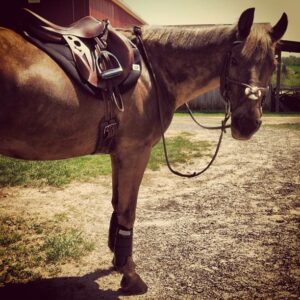When we started developing our line of horse boots, we took a look at the products that were already in the market.
First, as a textile engineering company, we know about materials. And we were amazed by the amount of ridiculous claims on labels: from breathable-neoprene (which doesn’t exist. Neoprene is an insulator and is not breathable) to 95%+ shock absorption (you can’t measure impact in an absolute percentage, it depends on the impact force). Yikes! No wonder people don’t know what to believe.
As a protective safety device, we were surprised that there weren’t uniform testing requirements that all manufacturers needed to comply with, specially with regards to impact, as there are for helmets or safety vests.
We did comparative studies, looked at the key important factors and also, talked to grooms and top riders to see how we could develop a horse boot that would offer the best protection to the horse.
1. IMPACT PROTECTION
First and foremost, the reason why you put a boot on your horse is for protection. When we started looking for the best impact material in boots, we discovered many choices.
Some boots use plastic shields, metal plates, and amazingly enough, some brushing boots don’t have any protection at all. The problem with the metal or plastic shield, is that even if it protects (some brands better than others) it remains stiff, which is not comfortable for the horse and has the potential to create rubs.
Our discussions with top riders and grooms made it clear that our boots needed to be flexible, so we had to look for a material that would not only have high impact strength, but also be flexible.
We found polycarbonate, a bullet-proof material designed to absorb shock in high-impact situations. Developed originally for the aerospace industry, polycarbonate is used for airline windows, NASA Space Shuttles and also for protective helmets, riot police shields and bullet-proof windows. There is plenty of data on its resistance to impact.
“With 20 times the impact resistance of fiberglass and over 40 times the impact resistance of glass or acrylic. At a thickness of .033″, a Polycarbonate sheet can withstand over 240 inch-pounds of impact. This equates to a 3/4″ hailstone falling at 96 miles per hour! Polycarbonate sheet maintains this superior impact resistance at temperatures ranging from 40°C to 250°C.”
We also did our own comparative impact test – hitting different brands with an axe. We were amazed by the results.
Besides the impact protection advantages, polycarbonate is very light, flexible and offers a uniform level of protection at different temperatures. So riding in tropical hot and humid or freezing conditions, would not affect its performance.
2. HEAT build-up – Breathability
Air-vents or no air-vents? As riders try to determine breathability by checking the number of air-vents on horse boots, we knew that our key advantage would be in making the entire surface of the boot entirely breathable, as we had successfully done for our dressage boots. So, our boot doesn’t need air-vents – which can help neoprene-boots become slightly more breathable but can also offer a weak impact point (less protection where it’s open) and allow sand and dirt to get in.
Our expertise in combining micro-fiber and our unique 100% breathable memory-foam (our breathable memory-foam is completely vented, like a mesh, so it does not trap moisture or heat in, as might happen with regular memory-foam) offer an entirely breathable surface, to quickly dissipate the heat.
There was an independent test done at a competition in the UK measuring the temperature of the horse’s legs after the XC. Results found that the horses using our boots were 1.5 degrees cooler than with the number one boot in the UK.
3. RESTRICTION – Flexibility
It was clear from the beginning that we needed to make very flexible boots, not only to offer greater comfort to the horse, but also reduce friction and prevent rubs. Stiff boots limit the freedom of movement
Rubs and skin irritation can be caused by the materials used (many horses are allergic to neoprene), but also due to the boot design. Top grooms strongly recommended making a boot without any trim to prevent friction.
The breathable memory-foam, which conforms to the horse’s legs with the flexibility of the Polycarbonate shield and designing the boots without any trim, feel like a second skin. That’s what you want. The more flexible, the more comfortable for the horse, but without compromising on the level of impact protection.
4. WEIGHT – One of the reasons why we are using the Polycarbonate shield is that it’s lightweight compared with other materials of similar resistance, which allows our boots to weigh as the lightest ones in the market approximately 250 grams.
The fact that they are 100% breathable allows them to quickly evaporate the sweat, maintaining their weight constant during a competition. By using water-repellent materials, the tests done on the field show that there is little water absorption when going through the water jumps.



